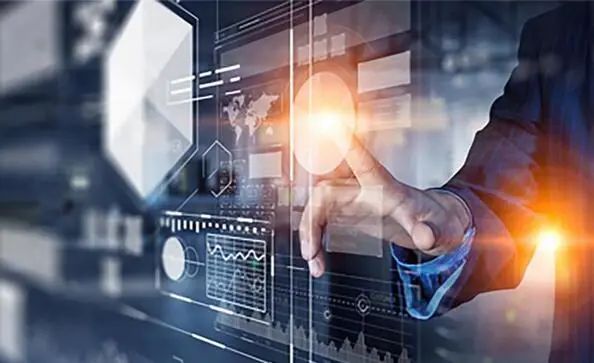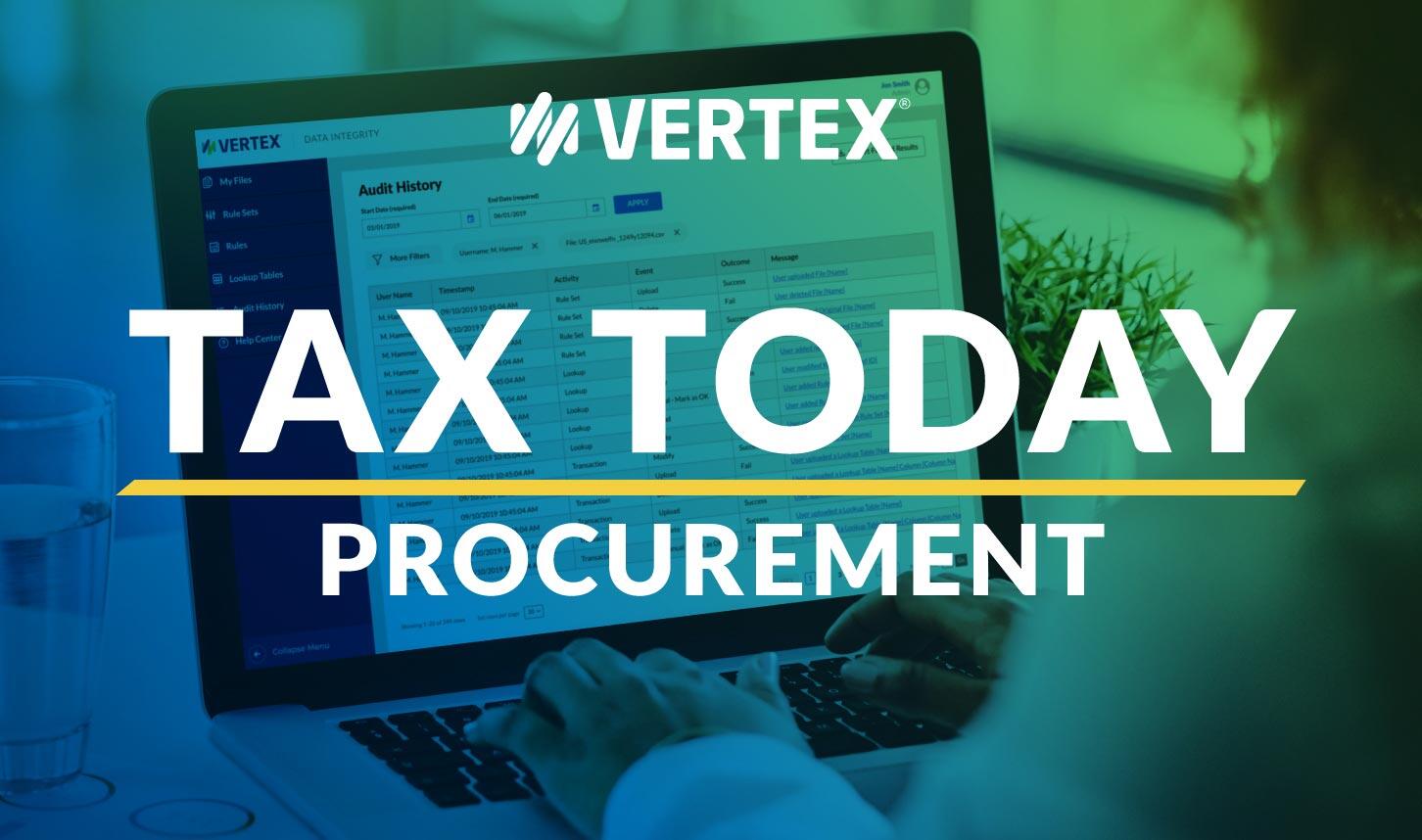MS. SCHAWBENBAUER: Hi, I'm Kristin Schawbenbauer. Welcome to Tax Today, a Vertex Podcast series. On today's episode, we'll be exploring key indirect tax points during the procurement buyer invoice process. Our guest today is a repeat Tax Today Podcast contributor, Peter Boerhof, from Vertex's chief taxation office.
Peter, thanks so much for joining us today.
MR. BOERHOF: Yeah, thanks for having me here again. And I'm looking forward to this podcast.
MS. SCHAWBENBAUER: So I'm excited about this topic. So, Peter, can we review the invoice process? Like give us a real rundown from soup to nuts.
MR. BOERHOF: Yeah. The invoice process differs according to the design of the specific business, of course, and how they've arranged everything. But in general, I would say that if the invoice is received it will be scanned using OCR or data will be manually processed by the AP clerk.
And then upon receipt, the three-way matches applied to verify if the invoice net amounts match with the amounts in the PO. To verify if the invoice net amounts match with the amounts in the PO and if the ordered goods have been received in full, that's a good receipt document.
And after this, based on the invoice or the scanned image, the AP clerk should verify if the invoice is legally correct from a VAT perspective. Basic checks include the usage of the correct company name and address and correct VAT numbers of both the buyer and offender and the correct VAT rate and amount. And in case of errors, the invoice should be returned to the vendor.
Checking the correct VAT treatment, it's important at this stage, as incorrectly charged VAT is not deductible. An incorrect invoice data results in incorrect VAT (Inaudible 1:50).
And VAT is not part of a three-way match. SPOs in general are exclusive of VAT.
MS. SCHAWBENBAUER: Great. So what happens during the invoice reconciliation process? Can you do a deep dive on that for us?
MR. BOERHOF: Yeah. What you do in an invoice reconciliation process is actually identifying and managing discrepancies between invoices and the related purchase orders, contracts, or receipts so that they can be paid. So the overall purpose is to pay an invoice in such a way that you've also received the goods and that it matches with everything that you expect.
Manually reconciling an invoice includes a series of steps in which one or more users investigate and resolve errors and exceptions. The first step is that you review the invoice reconciliation, or IR document, and decide whether to edit or reconcile the document. And if you reconcile it, just process and you go on, or it needs to be edited.
And if it needs to be edited, you need to check whether you can do edits yourself or whether it has to go through somebody else with the right authorizations in the system.
When you look at the exceptions, you can accept the data on the invoice or accept the data based on the associated purchase order, or the contract, or the receipt. You can edit line item details and you can handle tax exemptions.
And in the end, you will submit the invoice for reconciliation once all the edits have been done. And invoices can be reconciled with the combination of automatic and manual processing.
The automatic reconciliation phase matches invoices to orders or contracts within tolerances defined in your configuration. And it also refers to unresolved issues to users for manual reconciliation.
And if no exception exists, the automatic reconciliation process still creates the IR document, which must be approved according to the rules defined. And the tricky thing here is that the invoice, as received, is the leading document for VAT. So all data entered or modified in the system and in this process has to match with the invoice.
And for automating this process, one of the VAT challenges is that there are various reasons for having no or zero percent VAT on an invoice. This can be, for example, exemptions, export transactions, EU purchases, reversed charge, or for example, VAT grouping of other internal transactions. So there are quite some challenges in this whole reconciliation process and matching the data in your system with the related data on the invoice.
MS. SCHAWBENBAUER: Yeah, that seems to be challenging. It seems to be pretty tricky. As you mentioned, there's a lot of things to remember and there's a lot of things to take into account. Are there any pitfalls that you should advise, or we should advise our audience here to avoid?
MR. BOERHOF: Yeah. I've, in the past, experienced a few scenarios that are really difficult for the accounts payable department to process. And this difficulty can be due to a lack of knowledge or to a lack of priority. As in general, correct VAT processing is not part of the KPIs of that department.
So invoices, for example, for in the event at a hotel, like for example, a marketing event, with various VAT rates, a limit deduction on, for example, food and beverage is a processing challenge as each line has to be processed individually for VAT. And if you're on a production target for a number of invoices to be processed, these are not the most comfortable invoices to reach your production target.
And invoices' debts include a combination of services and goods can also be quite challenging as different VAT numbers have to be used and sometimes even different legal entities.
But one of the key challenges is the processing of standard invoices, so not these complicated ones, where master data in the system is not complete. And in all of these situations, you run the risk that AP gets creative to reach their targets and that can result in reduced deduction of VAT on your purchases. And as a VAT manager, of course, you would like to avoid that.
MS. SCHAWBENBAUER: I would imagine. But it seems like it's almost inevitable that you're going to have issues and challenges that pop up. And I think even from a U.S. perspective as well, it is scary. I think I heard you say a couple of things. Your master data, even with the standard process, if your master data isn't good, then you're in a world of hurt.
And then also, with regards to potentially having your AP clerk or professionals make a decision just to kind of process things, get things moving forward, it doesn't appear that with this situation you have a really great solution, especially if you're not automating, to help support this process, make it as efficient as possible, as well as adhere to all the legal regulations and to get your reduced deduction and things like that.
Does that make sense? Does that resonate with you?
MR. BOERHOF: Yeah, that absolutely resonates with me. And despite the fact that there may be challenges in automating this process, it'll be your carrot and stick to finally have your master data dated and correct and to improve this process significantly. So I fully agree, Kristin.
MS. SCHAWBENBAUER: No, that's great. I think that's a lot of really good feedback. There's a lot of good things for people to really take into consideration. So again, we go back to this theme that keeps popping up and I know this was kind of in the past from a European perspective, is that, well, that's just a rate and it's simple. It's not anything complex and you don't necessarily require using any kind of third-party tax, but it appears that that's just the opposite or it's evolving to be a lot more complicated than anyone kind of expected, especially on the purchasing side.
MR. BOERHOF: Yeah, that's absolutely true, Kristin. By many people and not by only European people, but also by finance managers, CFOs, VAT processing is too often seen as a routine activity that you can easily outsource or move around. And that really causes quite some issues.
MS. SCHAWBENBAUER: Yeah, I would imagine. I mean, a cost to the business, never mind as these procurement transformations take place, trying to get any best practices or KPIs it's just out the door completely. I would imagine that would be really challenging and extremely frustrating too because the indirect tax manager would be put in a really bad spot. So I think what you took through us today really helps us expand on that and really take a deep dive as to the nuances of why that is and things for our audience to consider. So I appreciate that.
That'll do it for today's show. I'd like to thank my guest Peter. Thank you for joining us, Peter.
MR. BOERHOF: Yeah, you're welcome. Thanks.
MS. SCHAWBENBAUER: And thanks to our listeners. Make sure to tune in for our next episode when we'll discuss the keys to a successful implementation.
Invoicing Explained: Understanding Indirect Tax During the Procurement Process
Episode 8 of Tax Today: Procurement

Episode 8 Summary
In this episode, podcast favorite Peter Boerhof, from Vertex’s chief taxation office, breaks down the full invoice process, addresses critical elements such as correct tax determination, and speaks on the complexities of VAT management. Throughout the conversation, he taps into his expertise around VAT, which your company may be facing if planning to expand, or already expanded into global markets.
Fortunately, there are tax technology solutions that can help companies overcome these VAT management challenges.
Episode 1: Why is Indirect Tax in Procure-to-Pay So Critical?
Episode 2: The Differences in Tax in the Procure to Pay Process: U.S. vs. Global
Episode 3: Indirect Tax in Procurement – Landscape, Opportunities, and Challenges
Episode 4: Indirect Tax in the Procurement Landscape: Opportunities and Challenges with Global VAT
Episode 5: Industry Perspective: Integrating a Tax Engine for a Global Motor Manufacturer
Episode 6: Aligning Tax and Procurement to Streamline Business Processes
Episode 7: Key Considerations When Deploying a Tax Solution for Procurement
Episode 9: Keys to a Successful Procurement Platform Implementation
Episode 10: Tax Reporting: Why Internal Audit and The Sarbanes-Oxley Act (SOX) are Essential
Episode 11: Technology Trends in P2P and Tax Automation
Episode 12: Understanding International Accounting: Global Indirect Tax and Procurement
Episode 13: Integrating Vertex with SAP Ariba: An Overview
Episode 14: Consumer Use Tax Audits: Pain Points and Solutions
About the Series
Still haven’t cracked the code on indirect tax and procurement? Let us help. On Tax Today, a Vertex podcast series, host Kristin Schwabenbauer holds enlightening discussions with tax, IT, and procurement specialists focused on shaping tax in the procure-to-pay process. Tune in every week for words of wisdom to help you transform tax.
Why add a tax engine for procurement?
Integrate a tax engine to improve tax accuracy and streamline procurement processes. Learn how in this video.
WATCH VIDEO
